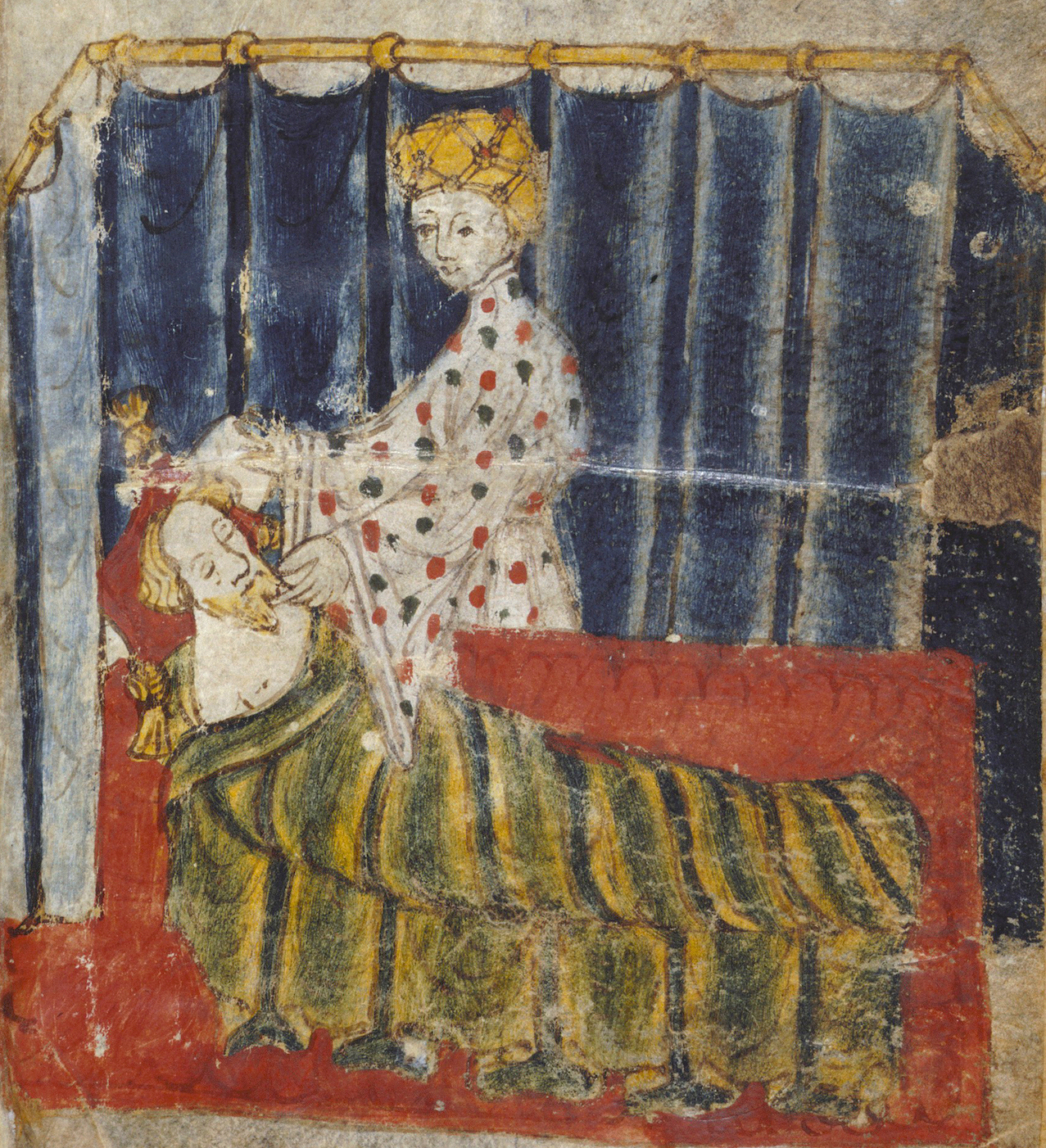|
Знакомые мотивы, по-видимому, вариация на тему смерти Иоанна Крестителя:

http://en.wikipedia.org/wiki/Gawain_and_the_Green_Knight
http://ru.wikipedia.org/wiki/Сэр_Гавейн_и_Зелёный_Рыцарь
К тому же далее попытки соблазнения Гавейна леди Бертилак напоминают не то историю с Иосифом и женой Потифара (т.е. "историю Есфири-Елены"?), не то искушение Адама Евой. Возможно, это всё варианты одной истории.

Scholars have pointed out parallels between the girdle Bertilak's wife offers Gawain, and the fruit Eve offered to Adam in the Biblical Garden of Eden.
...At the same time, those same actions make the Lady appear adulterous; some scholars compare her with Eve in the Bible.<76> By forcing Gawain to take her girdle, i.e. the apple, the pact made with Bertilak—and therefore the Green Knight—is broken.<77>
"Часто критики сравнивают зелёный пояс с терновым венцом Христа, а в самой поэме есть указание на «Бога в терновом венце»<11><32>."
http://en.wikipedia.org/wiki/Lady_Bertilak is a character in the medieval poem Sir Gawain and the Green Knight. She is ordered by her husband, the Green Knight, or Lord Bertilak, to test Sir Gawain's purity.
http://www.studentpulse.com/articles/270/mysticism-and-christianity-in-early-english-literature-comparing-beowulf-and-sir-gawain-and-the-green-knight
The beautiful wife of Bertilak reads strongly of two Biblical women, bringing alive the stories of Adam and Eve and of the temptation of Joseph. Unlike Grendel’s mother, who threatened men by acting like a man, the Lady of Bertilak is dangerous because she can manipulate her femininity and sexuality to tempt the opposite sex. When she comes to Gawain the third time, she uses her body to seduce Gawain into sin: “Her face and fair throat freely displayed / Her bosom all but bare, and her back as well” (197). The woman is clever as well, speaking with “artful words” and twisting his meaning to confuse and “hem him about” (198). Eve, who wore no clothes in the Garden, spoke to her husband and convinced him to eat from the Tree of Knowledge. Like Adam, Gawain cannot resist accepting her offer of the forbidden.
The Lady also symbolizes Potiphar’s wife, another temptress. When her husband was out working, the woman came to Joseph, her slave, and tried to entice him into her bed. Gawain dedicates himself to the Lady, swearing, “I prize the praise you have proffered me here / and soberly your servant, my sovereign I hold you / and acknowledge me your knight, in the name of Christ” (Sir Gawain 188). She pushes her body toward him as her servant while her husband is out. Like the story’s original protagonist, Gawain must refuse his mistress every day without angering or upsetting her. Unlike Joseph, however, Gawain does not trust his fate in the hands of God enough to refuse the Lady’s girdle.
The Veneries echo the temptations of Jesus; Gawain must withstand three occasions of temptation, just as Christ thrice had to refuse Satan’s lures. Just as the Devil tempts him in three different ways, the Lady’s tactics change a little with each visit. On the first occasion, she openly offers her body to him: “My body is here at hand, / Your each wish to fulfill; / Your servant to command / I am, and shall be still” (Sir Gawain 187). Second, she tries to guilt him into crossing the line, arguing, “Here by your side I have sat for two days / Yet never has a fair phrase fallen from your lips / of the language of love …. Do you deem me so dull, or so deaf to such words?” (193). On the third instance, she begins to ply him with objects of hers. Despite the symbols of perfection he bears, such as the Pentangle, Gawain is not as flawless as the Christ. He does not succeed in keeping above sin. By exchanging the kisses for Bertilak’s fox without returning the belt, Gawain takes on the symbolic actions of Judas. He betrays his host with a kiss. The writer brings these Bible stories to life by dressing them up in the form of a romantic tale with new circumstances.
Сюжет поэмы также связывают с возникновением Ордена Подвязки. Пояс и подвязка - близкие понятия. Может ли "история Есфири-Елены" быть причастна к возникновению Ордена Подвязки?
"Критики сравнивают поведение героев произведения с кодексом английского Ордена Подвязки. Девиз ордена 'honi soit qui mal y pense' («да устыдится тот, кто найдёт здесь зло») появляется в конце поэмы. Пояса, которые стали носить рыцари после приключения Гавейна, перекликаются с подвязками<9>. Возможно, девиз был приписан не автором, а писарем, тем не менее, он создаёт связь с этим рыцарским орденом<1>."
http://en.wikipedia.org/wiki/Order_of_the_Garter#Legendary_origins
http://ru.wikipedia.org/wiki/Джоанна_Плантагенет,_4-я_графиня_Кент известная под прозвищем Прекрасная Дева Кента
garter (n.)
early 14c., from Old North French gartier "band just above or below the knee" (Old French jartier, 14c., Modern French jarretière), from garet "bend of the knee," perhaps from Gaulish (cf. Welsh garr "leg"). Garter as the highest order of knighthood (mid-14c.), according to Froissart was established c.1344 by Edward III, though the usual story of how it came about is late (1614) and perhaps apocryphal.
|
